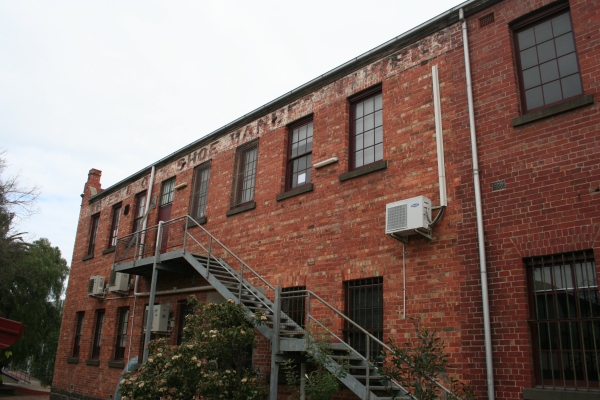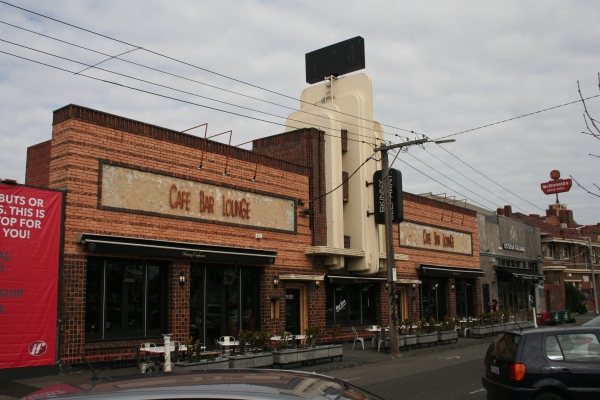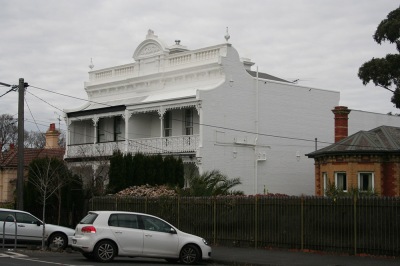Asked to name a favourite Victorian building in Melbourne, you might choose the Royal Exhibition Building, the Windsor Hotel or one of those crazy Gothic revival buildings on Collins Street. I’d chuck in a vote for the shot tower on Alexandra Parade, Clifton Hill, a masterpiece of industrial architecture.


Built in 1882, it’s the landmark you see as you zoom towards the entrance of the Eastern Freeway. If you always drive past, some time you should really stop and take a closer look at it. (My photos really don’t do it justice, sorry). Check out the way the circular tower tapers oh-so-gracefully towards its top, 80 metres from the ground.
I spend a lot of time on this walk around Melbourne staring up at things people have painted on walls. But sometimes the walls themselves are a work of art, and that’s certainly true in this case. Imagine the skill and courage of the teams of bricklayers – yes, it’s entirely built of brick – working up there, head-spinningly far from the ground, managing to create those elegant polychromatic bands, those attractive arched windows. What an achievement!
There are only two shot towers left in Victoria – the other one is Coop’s shot tower, now incorporated (rather inappropriately) under a glass dome in Melbourne Central, which makes it impossible to imagine what it was really like. This one, which was also run by the Coop family, retains its capacity to impress. It’s much taller than the one in Melbourne Central, and monsters the skyline – I’d like to see them put a glass dome over this baby.
The purpose of the tower was to enable molten lead to be dropped through a sieve from a great height into water, thus forming spherical shot when the lead hit the water. The higher the drop, the bigger the shot you ended up with, for loading into your gun. As an ammunition facility it was still operating well into the 20th century.
You can walk up close to it, slap your hand against the bricks, and think of the men who were employed here, climbing 80 metres up above the ground to work. Kind of like being a lighthouse keeper, but with boiling molten lead whistling past your ears. That’s a job that took some guts, and the potential for industrial accidents – during and after the construction – must have been scarily high.
Quite often people write in to this blog to tell me they had an ancestor who worked at a place I’ve mentioned. Well, if your grandad used to work in the shot tower, I salute him and I’d love to hear what it was like.
Writer Robyn Annear, author of several wonderful books on Melbourne history including Bearbrass and A City Lost and Found, has passed on a lovely anecdote from her twice-removed uncle, Charlie Pearce, an Argus journalist, who wrote this in 1942:
“In the 11.30 o’clock closing days, when the suburban hotel was often the artisans’ club, the Clifton Hill tower stood as a solemn warning to citizens who kept late hours. It was the custom of certain Collingwood residents in the habit of returning home late from the ‘club’ on pay night to pause and look up to the top of the tower to test their sobriety. If the top stood still all was well, but if the tower wavered it was a sure sign that it was not safe to return to their wives. So they solemnly retired to a neighbouring paddock to sleep off the effects of their conviviality in order that they might arrive home – late, exceedingly late, but ‘stone cold sober’.”
I imagine it might still serve that purpose today.
The suburb of Clifton Hill nestles in a triangle between the Eastern Freeway and Heidelberg Road, with Merri Creek as its eastern boundary. These days mainly residential, it was known as “the Toorak of Collingwood” in the 1880s. I don’t know how seriously that nickname was meant, as there was plenty of industry here – including an abbatoir, manure depot, and quarries. But it does have a bit of elevation, though the ‘Hill’ part of the name was apparently added by an astute real estate agent (ah, how many Melbourne names derive from that source?) There are still lots of solid Victorian terraces and some larger houses, along with red brick industrial conversions that indicate the suburb’s manufacturing past.
One of the more interesting of these is ‘the organ factory’ on Page Street, although confusingly you can see ghostsigns for Yates Boots and Shoes around the top. It was originally a boot factory, only becoming an organ factory later on. These days it’s a school and community arts space. Either way, it’s a grand solid building, with more of that ornamental brickwork the Victorians used to put on the most functional structures.


Here’s a picture of what the building looked like in 1982, when the organ factory signage was still legible.

Photo by John T Collins. Source: State Library of Victoria.
Moving into the 20th century, cheek by jowl on Queens Parade are two examples of moderne architecture, of which the Melbourne suburbs are richly endowed. (Here’s a link to my Facebook page, with a few more moderne/deco buildings around the suburbs). They were still building in brick, but in a few short decades the architectural style had radically altered. Both these two were designed by James Wardrop, a few doors and a few years apart in the 1930s. At number 199, the former United Kingdom Hotel is now a McDonalds. At number 205, Mosskito bar was formerly Clifton Motors.


The United Kingdom Hotel was much acclaimed when it was built. Rightly so, with those elegant curves like an ocean liner, the decorative horizontal stripes contrasting with the bold verticals. Here’s what it looked like in 1964.
Not far from Merri Creek stands Quarries Park. These days it’s all barbecue areas, skate parks and bike tracks, but if you check out 1945.melbourne you’ll get a sense of the size of the quarry that was here for more than a century. According to eMelbourne, Clifton Hill quarry was one of the first in Melbourne, opening in the 1830s. Convicts from the Collingwood Stockade were among the labourers, and the stone was used to build Pentridge Prison. You can imagine, if you like, desperate men hewing away at the rocks under your feet, next time you are pedalling along the bike track.
This is what a stone quarry was like in the 1860s (this isn’t Clifton Hill so far as I know, but you get the idea).
The demand for bluestone diminished as the brick industry took off (I’ll be dropping in on the former Brunswick brickworks soon), bricks being cheaper and lighter and more transportable than bluestone (imagine carting lumps of bluestone up to the top of that shot tower, for instance). Therefore many quarries were abandoned to be filled with rubbish and water. The same happened in the suburbs around where I live, in Yarraville and Footscray. For many years the suburbs were scarred with these old quarries, used as big receptacles for waste of all kinds. Many of them were finally converted into parks, as this one has been.
These days, the people of Clifton Hill are far more thoughtful about their rubbish disposal. There’s a recycling depot on Roseneath Street with a display of signage that appeals to me.

More on the shot tower, from the Collingwood Historical Society.






I’ve only just discovered this blog. Thanks. It really appeals to me.
Thanks Amanda, glad you like it.
Really interesting information. And you write in a very engaging way. Well done
Hi Nick, I am sitting in Brisbane doing a “theoretical” health focused, case study using Camp hill as the subject area, so your blog has been great to give me a bit of a feel for an area I don’t know. Really interesting Thanks!!